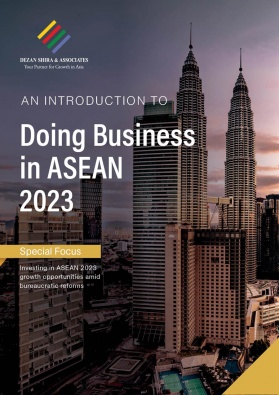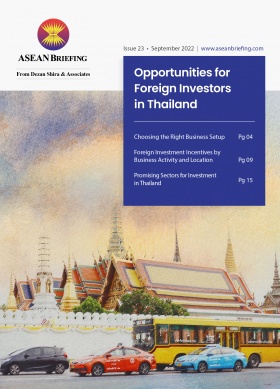Industries to Watch Out for Growth in Southeast Asia in 2023
Southeast Asia is home to several promising industries across its regional economy that will report quicker than the global average growth in 2023. Despite a concerning macroeconomic backdrop, various factors will continue to pull in investment and businesses to the region.
Southeast Asia, or the ASEAN (the Association of Southeast Asian Nations) region as more commonly referred to in Asia, is among the fastest-growing regions in the world. According to the Asian Development Bank (ADB), economic growth in Southeast Asia reached 5.5 percent in 2022.
However, a host of evolving and generally negative economic pressures is pushing down the growth forecast for the region by ADB – reflecting patterns elsewhere in the world – to 4.7 percent.
The International Monetary Fund (IMF) forecast for global growth was 3.2 percent for 2022 and 2.7 percent for 2023, meaning ASEAN is still forecast to grow substantially faster than the global average.
Despite the prevailing gloomy economic climate, Southeast Asia remains very attractive to foreign direct investment (FDI), and several industries look set to prosper in 2023. Trends of capital inflow into key sectors, such as tech, manufacturing, and infrastructure development, will likely continue while China’s ‘reopening’ will provide a much-needed boost for tourism and travel from the second quarter (Q2 2023).ASEAN growth trends
The region is on course to become the world’s largest single market by 2030. This is reflected in the investment flows that have continued at a high level in recent years. ASEAN states are becoming increasingly open to international trade having incrementally removed barriers to inter- and intra-regional trade and investment.
The growth of Southeast Asia’s indigenous economies also offers a lucrative environment for foreign businesses, as also the sheer size of the regional population and workforce. ASEAN countries have a total population of 662 million people and a combined gross domestic product (GDP) of US$3.2 trillion.
Growth patterns will be boosted as economies and workforce arrangements become more formalized and more young people enter the labor market. The median age in Southeast Asia is 30.2 years, substantially less than in China (38.4) and Europe (44.1).
Finally, the ASEAN region has benefitted, and will likely continue to benefit, from a privileged geopolitical position. An intensifying rivalry between superpowers, the US and China, have prompted both nations to deepen their ties with the region.
China has considerable links with ASEAN economies and seeks to enhance them through increased infrastructure spending and by improving access to trade, such as through the Regional Comprehensive Economic Partnership (RCEP).
What are the promising industries for Southeast Asia in 2023?
Manufacturing
There are clear challenges for the region’s manufacturing sector in 2023. We’re seeing downward pressure on demand across the world, predominantly in advanced economies, which will impact manufacturing activity in the ASEAN states.
Other challenges include rising interest rates, which increase the cost of borrowing and therefore growth, and inflation, which puts pressure on margins at a time when demand is already under pressure.
Manufacturing is an important part of the regional economy. In some countries, this dependence on manufacturing is more pronounced – in Vietnam, it is the backbone of the economy, and in Thailand – the sector contributed 27 percent of GDP in 2021.
However, there are several reasons to believe that capital inflows into manufacturing in the region will continue in 2023. For one, ASEAN-made goods are generally considered more cost-effective than those made in China, primarily due to factors such as labor costs, leading to the growing shift to ASEAN.
In addition to lower labor costs, the US-China trade war has forced many China-based manufacturers to move part of, and in some cases, all of their supply chains to Southeast Asia.
Chasing this ‘China Plus One’ or ‘China Plus Many’ strategies, ASEAN governments have issued preferential incentives and enabling policies to capitalize on this shift in regional supply chains. This includes implementing tax cuts, increasing the ease of doing business, boosting infrastructure spending, and offering incentives in special economic zones and free trade areas.
Vietnam has been one of the largest beneficiaries of the China Plus One strategy in recent years, with the manufacturing sector attracting some 58 percent of total FDI in the country in 2020 alone.
Tourism
Since the start of the pandemic, the tourism sector has faced challenges across ASEAN states. It plays an important role in several of the region’s economies and is also one of the key areas of ASEAN cooperation since the establishment of the association.
Thailand was the most-visited ASEAN state, welcoming nearly 40 million visitors in 2019. It was the first country in the Asia Pacific to initiate the reopening to international tourism back in July 2021 with its Phuket Sandbox program. However, while 2022 data is yet to be finalized, visitor numbers remain significantly down over the pre-pandemic era. It is understood that around 10 million people visited Thailand in 2022.
Vietnam’s tourism sector has been struggling too. The state will likely have welcomed 3.5 million tourists in 2022, a mere 18 percent of the 19 million international arrivals in 2019.
However, there are several reasons to expect 2023 to be a more positive year for the sector. First among these is China’s ‘reopening’ to travel. The Chinese immigration authority recently announced that it would resume issuing visas for mainland residents to travel overseas from January 8. A lack of Chinese tourists had been seen as the predominant challenge for the sector in most ASEAN states.Another reason is returning demand for tourism elsewhere in the world. US households are continuing to unleash two- or three years’ worth of pent-up demand as Covid-19 fears wane according to data shared by CNBC. The Asia Pacific is among the most popular destinations.
Demand for travel is continuing in Europe, despite inflationary challenges, while airlines are increasing routes and injecting more supply.
Further, ASEAN states have also developed programs to attract foreign arrivals, such as the digital nomad visa program in Malaysia, and Indonesia’s second home visa scheme. Indonesia has set an ambitious target of attracting 7.4 million foreign tourists for 2023, almost double that recorded in 2022.
Digital economy
The digital economy across the ‘ASEAN-6’ (Indonesia, Malaysia, the Philippines, Singapore, Thailand, and Vietnam) is expected to reach a gross merchandise value (GMV) of US$200 billion by the end of 2022, according to a report from Google, Temasek and Bain & Company. This is expected to reach a GMV of US$330 billion by 2025.
Over the past three years, the region saw the emergence of 100 million new internet users. In many countries around the world, internet adoption was enhanced by the pandemic as the virus restrictions placed on socializing and public activity impacted offline shopping and entertainment, etc.
Tech start-ups are well-represented in Southeast Asia’s booming start-up ecosystem. According to a recent UNCTAD report, the number of start-ups in ASEAN that have raised more than US$1 million in funding almost tripled to 1,920 between 2015 and 2021. The growth rate is 85 percent greater than in Europe and 65 percent faster than in the US.
The digital transformation agenda continues to be a major driver of investment and growth in the region. Importantly, the expanding digital economy offers huge opportunity scope in the area of digital financial services.
The majority of Southeast Asia’s population is still unbanked or underbanked and the majority of workers are in the informal sector, thus lacking bank accounts and making it difficult for banks to build a credit history.
Further, MSMEs in the region also lack formal credit histories hindering their access to capital. This is crucial as MSMEs make up the backbone of most ASEAN countries. Fintech companies can plug this gap by issuing microloans that have terms and maturity which are small and short – borrowers can receive as little as US$100, which can be disbursed within 24 hours.
About Us
ASEAN Briefing is produced by Dezan Shira & Associates. The firm assists foreign investors throughout Asia and maintains offices throughout ASEAN, including in Singapore, Hanoi, Ho Chi Minh City, and Da Nang in Vietnam, in addition to Jakarta, in Indonesia. We also have partner firms in Malaysia, the Philippines, and Thailand as well as our practices in China and India. Please contact us at asean@dezshira.com or visit our website at www.dezshira.com.







